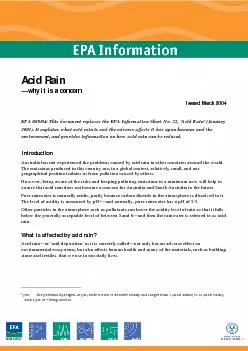/


Anthropogenic sources Nitrogen oxides are produced mainly from the burning of fossil fuels such as petrol in cars and from power stations burning coal Sulphur dioxide is formed primarily in the bur ID: 234466
Download Pdf The PPT/PDF document "Acid rain: why it is a concern—Marc..." is the property of its rightful owner. Permission is granted to download and print the materials on this web site for personal, non-commercial use only, and to display it on your personal computer provided you do not modify the materials and that you retain all copyright notices contained in the materials. By downloading content from our website, you accept the terms of this agreement.
Acid rain: why it is a concern—March 2004 Anthropogenic sources Nitrogen oxides are produced mainly from the burning of fossil fuels, such as petrol in cars and from power stations burning coal. Sulphur dioxide is formed primarily in the burning of (sulphurcontaining) coal and fossil fuels, and in metal smelters. In Adelaide in 2000, an estimated 66% of nitrogen oxides (including NO and NO ) came from motor vehicles, with a further 20% from fuel combustion. Petroleum refinery processing produced 40% of the sulphur dioxide emitted to the atmosphere, with motor vehicles contributing 22% and fuel combustion 15%. How are the acids deposited? Acidic pollutants are deposited on the ground either in a wet form through rain, fog or snow, or as dry matter, such as gases or particulates, falling directly from the atmosphere to the ground. The term ‘acid deposition’ describes all these possibilities and therefore is generally preferred to ‘acid rain’. Environmental problems from dry deposition tend to occur closer to the source of the pollution, but wet deposition can occur up to hundreds of kilometres away, in a different region or country, because microscopic aerosol droplets can be carried in clouds. Diagram of the ‘acid deposition’ process (reproduced with permission from New Scientist Inside Science RBI: 5 November 1987. http://www.newscientist.com How we can reduce acid rain The most effective way to reduce the incidence of acid deposition is to reduce the emission of its causes—the ‘precursors’, nitrogen oxides and sulphur dioxide. Nitrogen oxide reduction The main method of lowering the levels of nitrogen oxides is by a process called ‘catalytic reduction’, which is used in industry and in motor vehicles. For example, a catalytic converter fitted to a car’s exhaust system will convert much of the nitric oxide from the engine exhaust gases to nitrogen and oxygen. In Australia, all motor vehicles built after 1985 must be fitted with catalytic converters. page 4 Acid rain: why it is a concern—March 2004 Kemp, D 1994, Global environmental issues: A climatological approach, 2nd ed., Routledge, London. Fred Pearce 1987, Inside Science: Acid Rain, New Scientist, 5 November.White, V 1998, Air emissions inventory for the Adelaide airshed 1995, Environment Protection Agency, South Australia. McCormick, J 1997, Acid earth: The politics of acid pollution, Earthscan, London.Horseman, D & Carnovale, F 1989, Acid rain in Australia: A national assessment, Australian Environment Council, Report No. 25, Australian Government Publishing Service, Canberra. FURTHER INFORMATION Legislation Legislation may be viewed on the Internet at: www.parliament.sa.gov.au/dbsearch/legsearch.htm Copies of legislation are available for purchase from Government Information Centre Telephone: 13 23 24 Lands Titles Office, 101 Grenfell Street Internet: shop.service.sa.gov.au Adelaide SA 5000 For general information please contact: Environment Protection Authority Telephone: (08) 8204 2004 GPO Box 2607 Facsimile: (08) 8204 9393 Adelaide SA 5001 Freecall (country): 1800 623 445 epainfo@e.sa.gov.au Internet: www.epa.sa.gov.au page 6